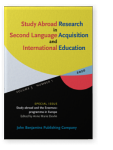Introduction
Study abroad and the Erasmus+ programme in Europe
Perspectives on language and intercultural learning
Article outline
- 1.Introduction
- 2.The global landscape
- 3.Erasmus+ within the global landscape
- 4.Presentation of the contributing articles
- Notes
-
References
References (33)
References
Bótas, P. C. P., & Huisman, J. (2013). A Bourdieusian analysis of the participation of Polish students in the ERASMUS programme: Cultural and social capital perspectives. Higher Education, 66(6), 741–754. 

Courtois, A. (2017). The significance of international student mobility in students’ strategies at third level in Ireland. Dublin: National University of Ireland.
Devlin, A. M. (2019). The interaction between duration of study abroad, diversity of loci of learning and sociopragmatic variation patterns: A comparative study. Journal of Pragmatics, 1461, 121–136. 

Dewey, D. P. (2017). Measuring social interaction during study abroad: Quantitative methods and challenges. System, 711, 49–59. 

Eder, K. (2009). A theory of collective identity making sense of the debate on a “European identity.” European Journal of Social Theory, 12 (4), 427–447. 

Egron-Polak, E., & Hudson, R. (2014). Internationalization of higher education: Growing expectations, fundamental values. IAU 4th Global Survey. Paris: International Association of Univerisities.
European Commission. (2014). The Erasmus impact study. Retrieved from <[URL]> (20 September, 2019).
European Commission. (2015). Erasmus: Facts, figures and trends. The European Union support for student and staff exchanges and university cooperation in 2013–2014. Retrieved from <[URL]> (4 September, 2019).
European Commission. (2017). Strengthening European identity through education and culture: The European Commission’s contribution to the leaders’ meeting in Gothenburg. Retrieved from <[URL]> (4 September, 2019).
European Commission. (2018). Report from the Commission to the European Parliament, the Council, the European Economic and Social Committee and the Committee of the Regions: Mid-term evaluation of the Erasmus+ programme (2014–2020).
European Commisson. (n.d.). Online Linguistic Support. Retrieved from <[URL]> (13 September, 2019).
Freed, B., Dewey, D. P., Segalowitz, N., & Halter, R. (2004). The Language Contact Profile. Studies in Second Language Acquisition, 26(2), 349–356. 

González, C. R., Mesanza, R. B., & Mariel, P. (2011). The determinants of international student mobility flows: An empirical study on the Erasmus programme. Higher Education, 62(4), 413–430. 

Howard, M. (Ed.). (2019). Study abroad, second language acquisition and interculturality. Bristol: Multilingual Matters.
International Organisation for Migration. (2008). World migration 2008. Geneva: International Organisation for Migration. 

International Organisation for Migration. (2018). 2018 World migration report. Geneva: International Organisation for Migration.
King, R., & Raghuram, P. (2013). International student migration: Mapping the field and new research agendas. Population, Space and Place, 19(2), 127–137. 

Kubota, R. (2016). The social imaginary of study abroad: Complexities and contradictions. Language Learning Journal, 44(3), 347–357. 

Kuteeva, M., & Airey, J. (2014). Disciplinary differences in the use of English in higher education: Reflections on recent language policy developments. Higher Education, 67(5), 533–549. 

Llanes, À., Arnó, E., & Mancho-Barés, G. (2016). Erasmus students using English as a lingua franca: Does study abroad in a non-English-speaking country improve L2 English? Language Learning Journal, 44(3), 292–303. 

Llurda, E., Gallego-Balsà, L., Barahona, C., & Martin-Rubió, X. (2016). Erasmus student mobility and the construction of European citizenship. Language Learning Journal, 44(3), 323–346. 

Marinoni, G. (2019). Internationalization of higher education; an evolving landscape locally and globally. IAU 5th Global Survey. Göttingen: Duz.
Mitchell, R., Tracy-Ventura, N., & McManus, K. (2017). Anglophone students abroad: Identity, social relationships and language learning. London: Routledge. 

Murphy-Lejeune, E. (2002). Student mobility and narrative in Europe. London: Routledge.
Önen, S. (2017). An investigation into the experiences of Erasmus students. Journal of Hasan Ali Yücel Faculty of Education, 11, 339–367.
Robertson, S. L., & Kedzierski, M. (2016). On the move: Globalising higher education in Europe and beyond. Language Learning Journal, 44(3), 276–291. 

Sandström, A.-M., & Hudson, R. (2018). The EAIE Barometer: Internationalisation in Europe (2nd ed.). Amsterdam: The European Association for International Education.
Sigalas, E. (2010). Cross-border mobility and european identity: The effectiveness of intergroup contact during the ERASMUS year abroad. European Union Politics, 11(2), 241–265. 

Souto-Otero, M., Huisman, J., Beerkens, M., de Wit, H., & Vujić, S.Č. (2013). Barriers to International Student Mobility: Evidence From the Erasmus Program. Educational Researcher, 42(2), 70–77. 

UNESCO Institute for Statistics. (2018). UIS Statistics. Retrieved from <[URL]> (23 July, 2019).
Van Mol, C. (2013). Intra-European student mobility and European identity: A successful marriage? Population, Space and Place, 19(2), 209–222. 

Warwick, P., & Moogan, Y. J. (2013). A comparative study of perceptions of internationalisation strategies in UK universities. Compare, 43(1), 102–123. 

Cited by (2)
Cited by two other publications
Devlin, Anne Marie, Annarita Magliacane & Michał B. Paradowski
2024.
Social Aspects in Language Learning: New Perspectives from Study‐Abroad Research.
Language Learning 
Strawbridge, Tripp
2023.
The relationship between social network typology, L2 proficiency growth, and curriculum design in university study abroad.
Studies in Second Language Acquisition 45:5
► pp. 1131 ff.

This list is based on CrossRef data as of 29 october 2024. Please note that it may not be complete. Sources presented here have been supplied by the respective publishers.
Any errors therein should be reported to them.
